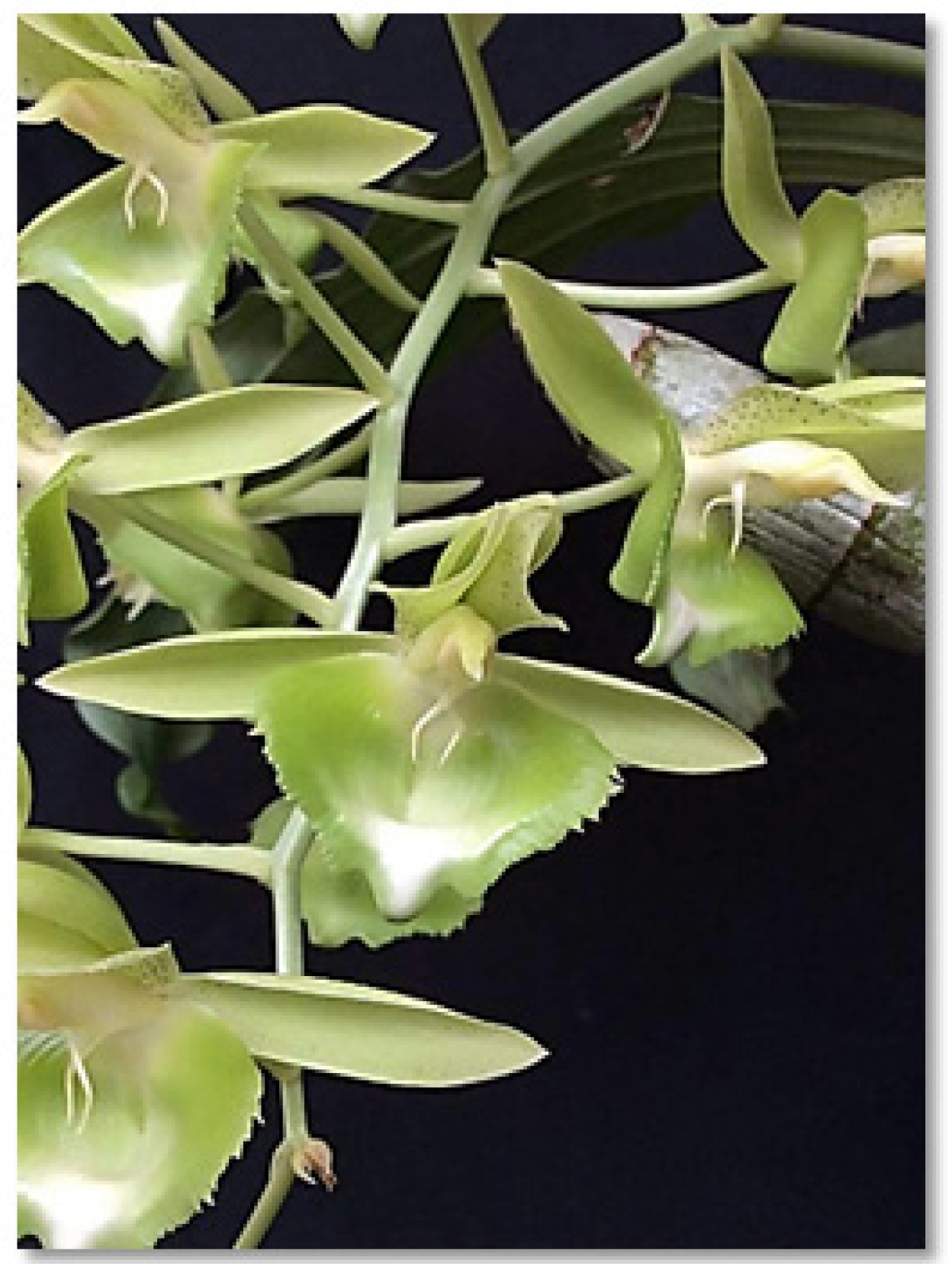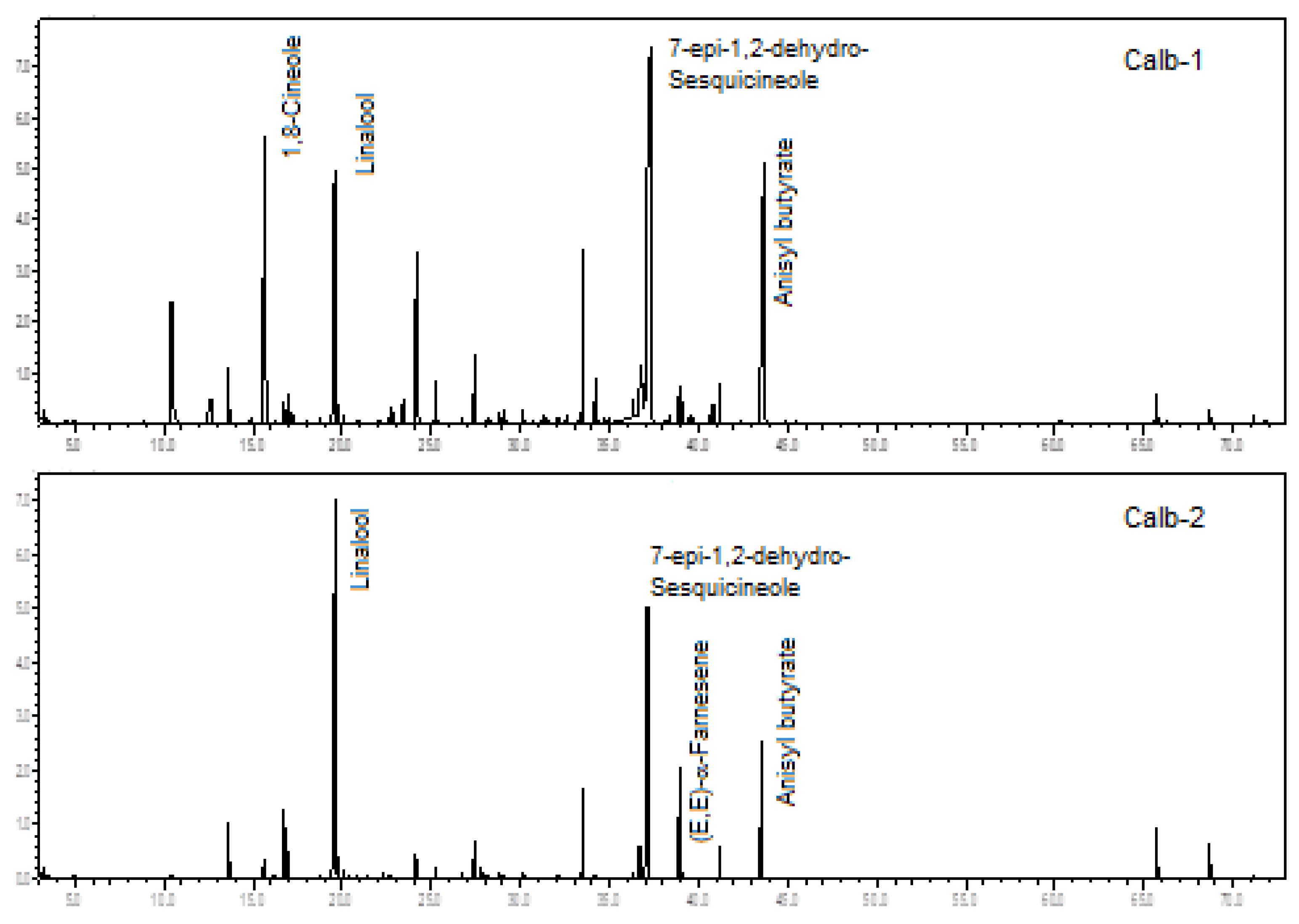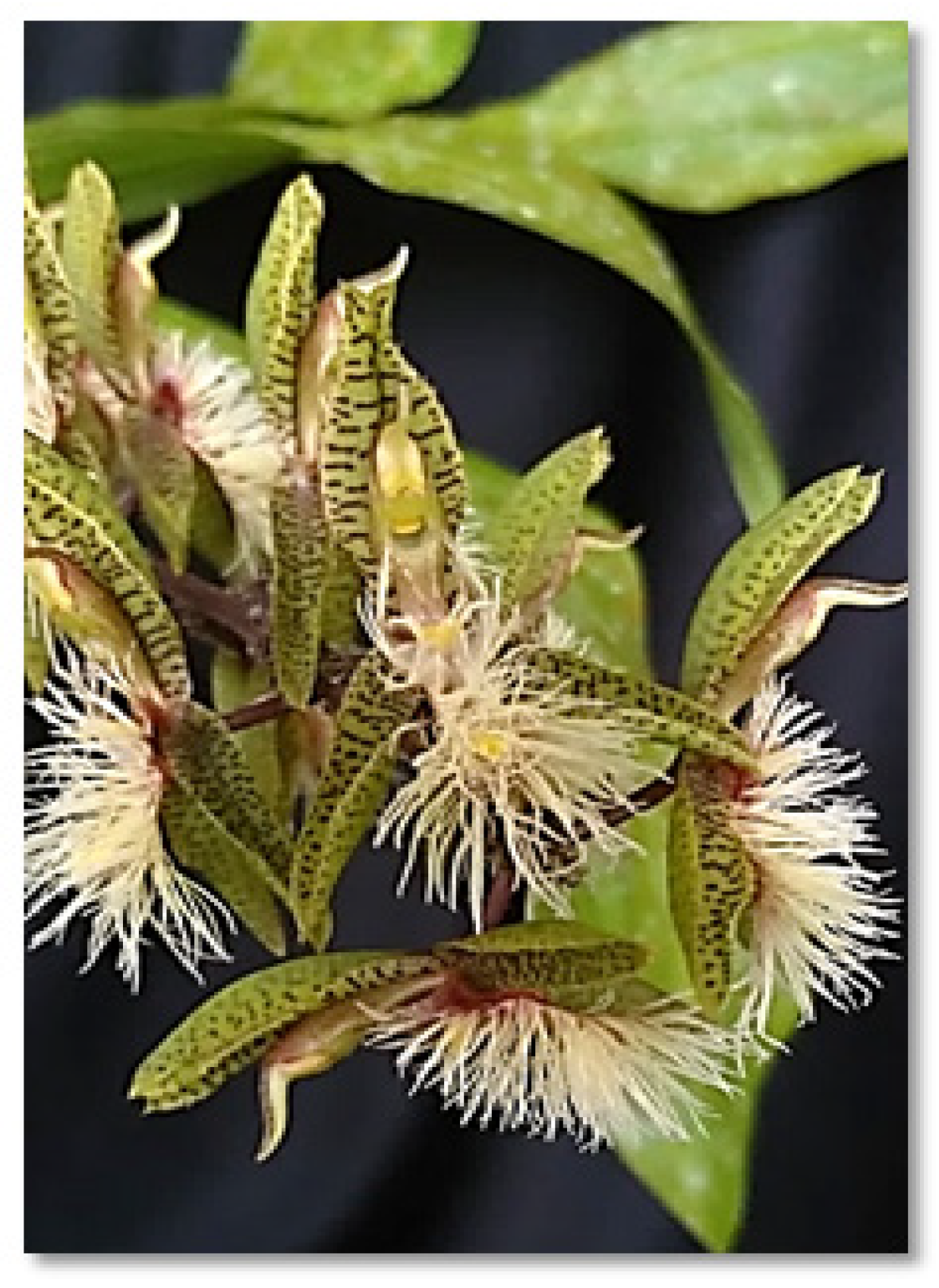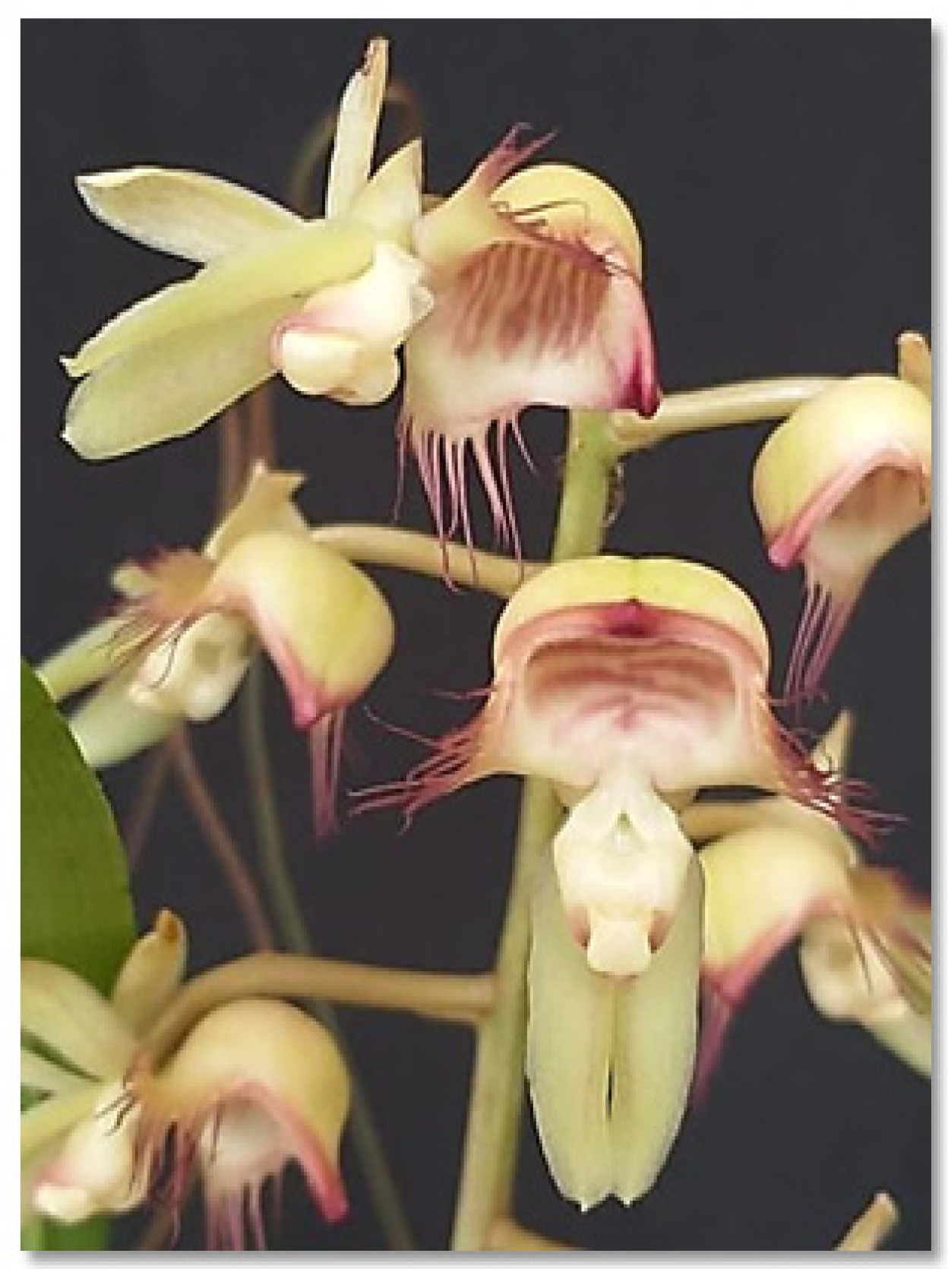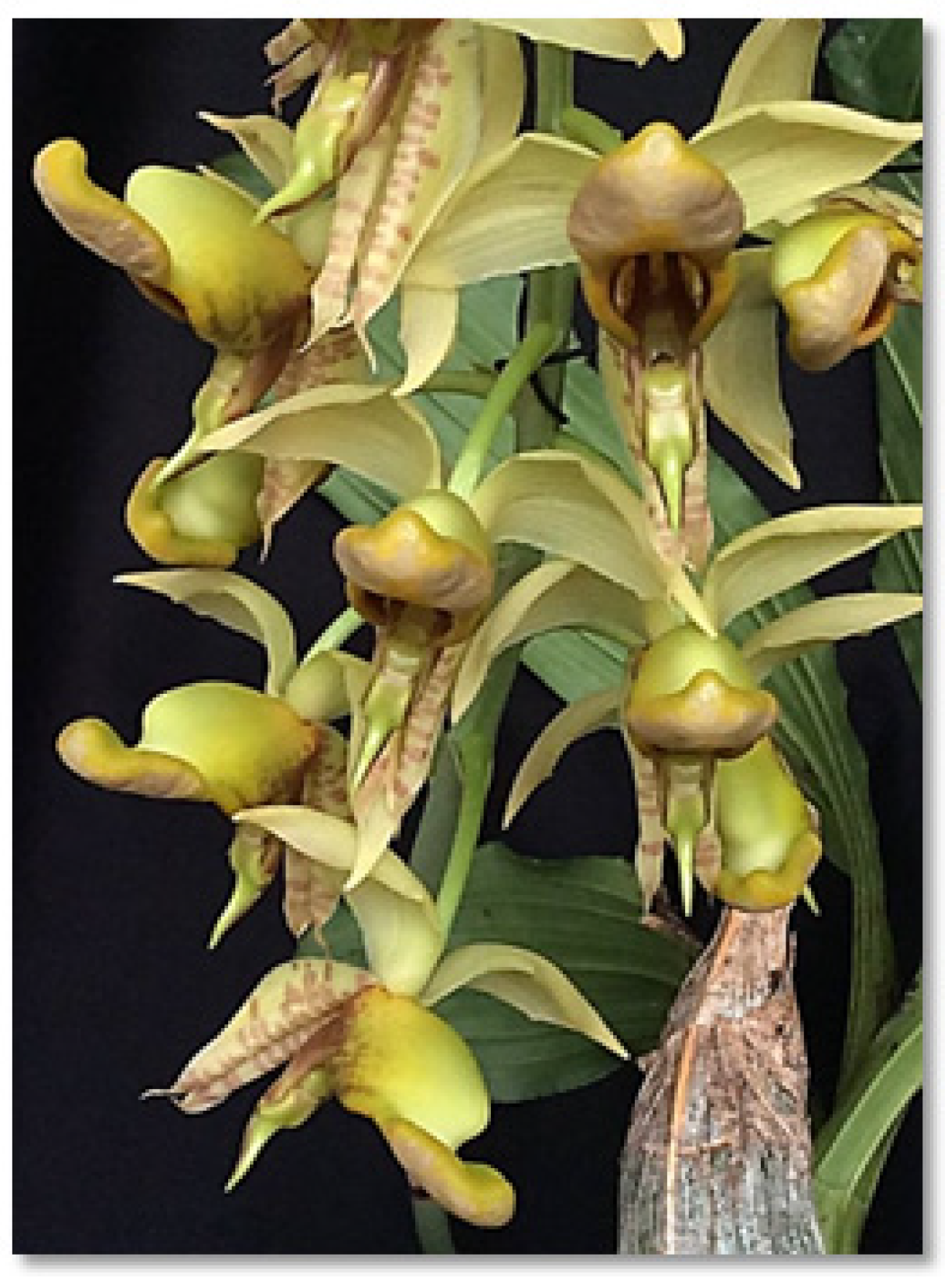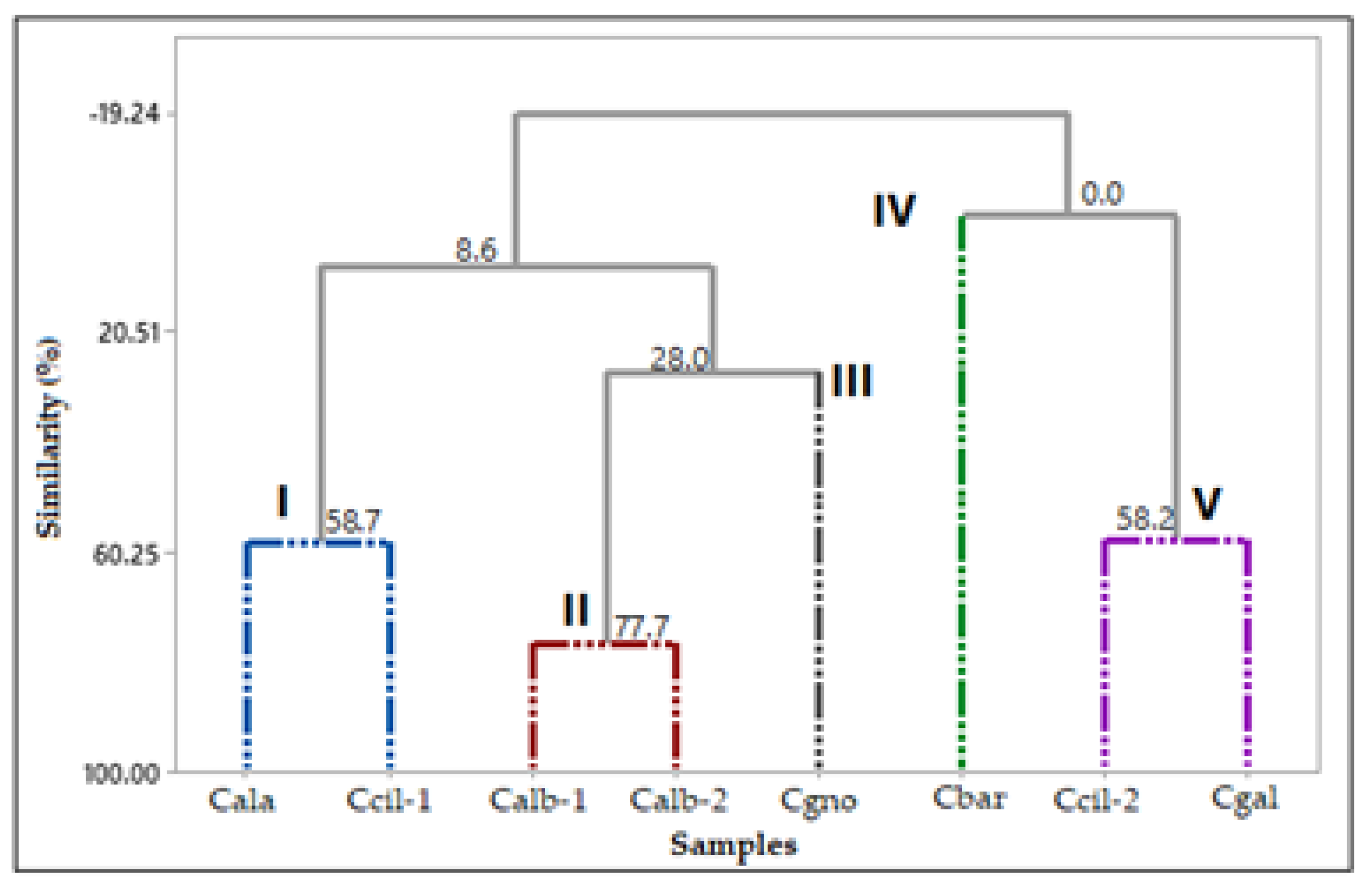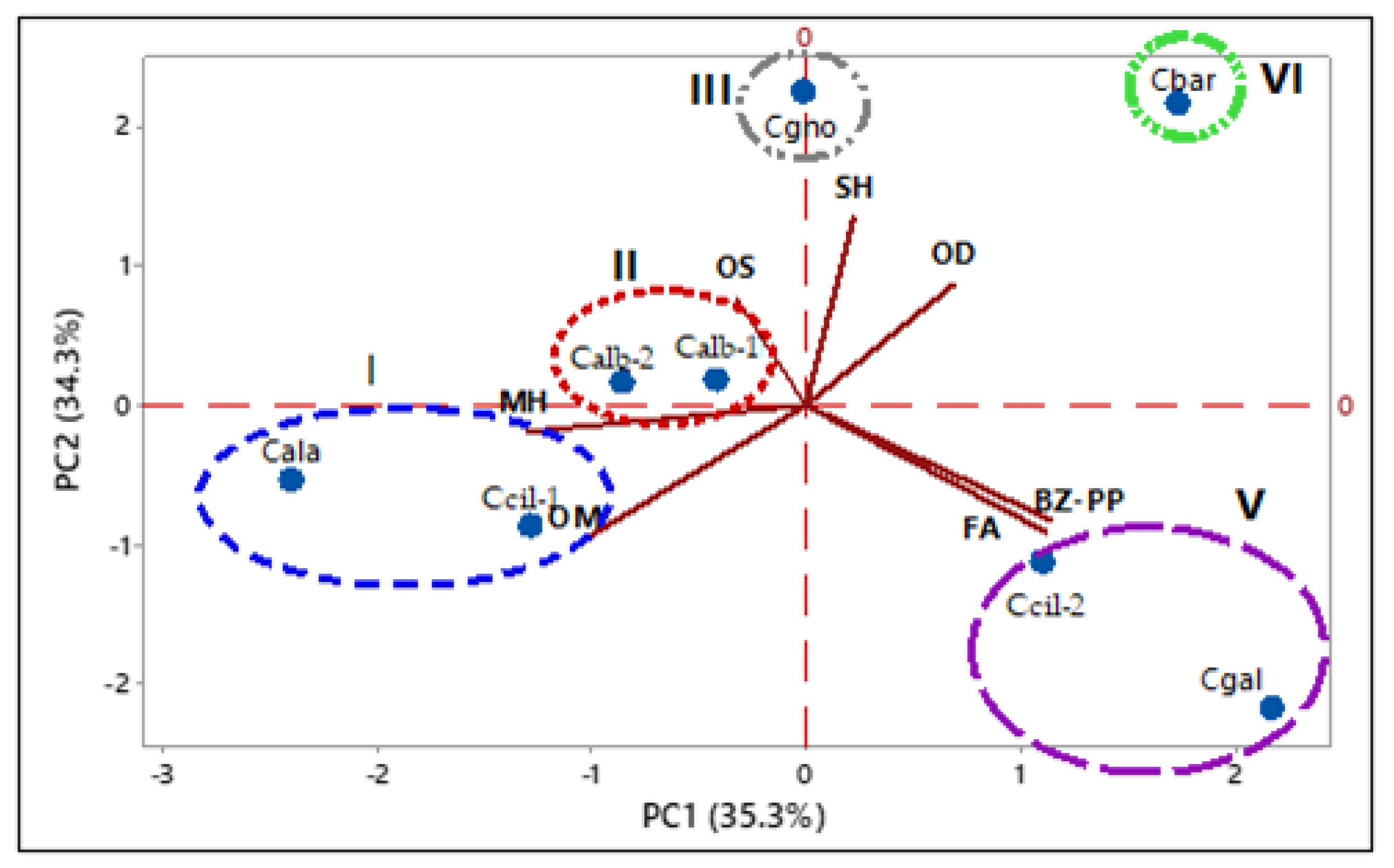2.1. Catasetum Rich. ex Kunth
2.1.1. Catasetum alatum M.F.F.Silva & A.T.Oliveira
Botanical description: Epiphyte. Pseudobulbs aggregated, multi-ringed, fusiform, erect; apex abruptly acuminate. Leaves membranous, lanceolate, slightly wavy margins, five to eight leaves per pseudobulb, and three thin veins. Inflorescence 10 to 20 flowers (
Figure 1), basal and pendant. Flowers staminate, resupinate jade green, erect, and distribute in the rachis’s middle third. Dorsal sepal lanceolate, erect, slightly concave; lateral sepals erect, linear-lanceolate, green, arched backward, acuminate. Petals oblong-lanceolate, greenish, convex, erect, margins slightly serrated. Fleshy lip, jade-green, 90° angle with the spine; frontal opening or elliptical ostium, internally light green, white spot at base, sack form at middle portion; edges of lateral lobes strongly winged, semi-curled, slightly serrated, asymmetrical, raised; triangular terminal lobe, apiculate, facing downwards, edges smooth [
17]. Flowering in December and January.
Geographic distribution: Endemic in Brazil. Occurrence for the North region of Brazil, State of Rondônia, in riparian or gallery forest areas [
17].
The specimen of
C. alatum in this study was sampled initially in the locality of Vila Nova California, Rondônia, Brazil.
Table 1 lists the constituents of its volatile concentrate.
Oxygenated monoterpenes (57.0%) predominated in the volatile concentrate of
C. alatum, followed by monoterpene hydrocarbons (36.9%). The main constituents were geraniol (29.7%), limonene (18.2%), α-pinene (11.8%), and linalool (8.8%) (see
Figure 2). The floral scents of
C. alatum are being described for the first time.
2.1.2. Catasetum Albovirens Barb. Rodr.
Botanical description: Epiphyte. Fusiform pseudobulbs. Leaves with longitudinal veins, elliptical-lanceolate, sharp at the base, attenuated in canaliculate pseudo petiole. Inflorescence about 25.0 cm, erect and at middle curved in a basal arch, multiflora. Flowers (
Figure 3) not resupinate, white-green to pink-green, drooping. Pedicel patent and twisted. Oval or oval-oblong sepals, obtuse or very sharp; erect dorsal sepal with five prominent veins; oblique lateral sepals. Petals lanceolate and acuminate with three very distinct veins. Lip nearly globular, distinctly 3-lobed, crass-fleshy, generally greener than other segments; lateral lobes rounded, entire, curved; terminal lobe patent, reflex, more or less 3-lobed or truncated, glabrous and smooth on the inside. Oval column, with rostellum, acuminate and straight. Antennae about 6.0 mm, extending to the front [
17]. Flowering in February to May.
Synonimy:Catasetum lamosii Rolfe [
17].
Geographic distribution: Endemic in Brazil, occurring in the states of Amazonas, Pará, Maranhão, Mato Grosso, and Tocantins, in anthropic areas such as rupestrian fields, high and flooded forests, seasonal deciduous forests, and savannas [
17].
Two specimens of
C. albovirens were analyzed. Specimen Calb-1 was sampled initially in the municipality of Muaná, Ilha do Marajó, and specimen Calb-2 was collected initially in the municipality of Tucuruí, Pará state, Brazil.
Table 2 lists the constituents of their volatile concentrates.
The two analyzed specimens of
C. albovirens were rich in oxygenated monoterpenes (52.4% and 36.7%), oxygenated sesquiterpenes (30.4% and 20.8%), and benzenoids (7.5% to 15.4%). There was a predominance of linalool (10.0% to 39.5%), 7-
epi-1,2-dehydro-sesquicineole (19.3% to 28.3%), anisyl butyrate (7.5% to 15.4%), 1,8-cineol (1.1% to 11.7%), and (
E,
E)-α-farnesene (1.0% to 5.2%), analyzing both specimens (see
Figure 4).
A previous comparative biology study of
C. albovirens showed β-myrcene, eucalyptol (1,8-cineole), (
E)-β-ocimene, linalool, 2,4-dimethylacetophenone, indole, (
E)-8-hydroxy-linalool, methyl anthranilate, geranyl acetate, and (
E,
E)-farnesene, as primary constituents [
18]. Therefore, presenting some chemical similarities to the two samples currently analyzed.
2.1.3. Catasetum barbatum Lindl.
Botanical description: Epiphytic, occasionally terrestrial. Fusiform pseudobulbs, about 15.0 to 5.0 × 3.0 to 5.0 cm long. Narrow, plicate leaves with a midrib and two lateral ones. Inflorescence suberect or arched with up to 20 flowers. Flowers (
Figure 5) male resupinate, greenish with brown spots. Sepals are lanceolate to dorsal erect, the lateral ones reflexed on the pedicel. Petals lanceolate and erect, margins finely serrated, somewhat revolute. The lips include hairs that may be white or greenish; the basal callus may be simple or bifurcated, usually surrounded by pilosity. Column light green or brownish. Cream anther. Yellow pollinia are hard and compressed on a white laminar stipe and a white viscid disc. Flowering in April and May [
17].
Synonimy:Catasetum barbatum var.
spinosum Rolfe,
C. brachybulbon Schltr.,
C. buchtienii Kraenzl.,
C. comosum Cogn.,
C. crinitum Linden,
C. polydactylon Schltr.,
C. proboscideum Lindl.,
C. rionegrense Campacci & G.F. Carr,
C. spinosum (Hook.) Lindl.,
C. variabile Barb. Rodr.,
Myanthus barbatus Lindl.,
M. barbatus var.
immaculatus Knowles and Westc.,
M. spinosus Hook. [
17].
Geographic distribution: Not endemic in Brazil, but found in upland and floodplain forests, broadleaf forests, mangrove and palm groves, and vegetation on rocky outcrops in the states of Amazonas, Pará, Roraima, Tocantins, Alagoas, Bahia, Ceará, Maranhão, Paraíba, Pernambuco, Piauí, Distrito Federal, Goiás, Mato Grosso do Sul, Mato Grosso, and Minas Gerais [
17].
The specimen of
C. barbatum in this study was sampled initially in the municipality of Ourilândia do Norte, Pará, Brazil.
Table 3 lists the constituents of its volatile concentrate.
In this volatile concentrate of
C. barbatum flowers, the major constituents were the
trans-geranylgeraniol (61.2%), an oxygenated diterpene, the (
E)-β-farnesene (16.4%), a sesquiterpene hydrocarbon, and the indole (11.3%), a heterocyclic aromatic compound (see
Figure 6).
The floral scents of
C. barbatum were previously analyzed. Two morphological variants originated from Brazil and Ecuador has differed in fragrance. The Brazilian form showed as primary constituents 1,8-cineole (16.1%), a-pinene (7.9%), and an unidentified main oxygenated monoterpene (46.1%), while the Ecuadorian form displayed ocimene (67.7%) as the main compound [
19]. Also, another paper on
C. barbatum floral scent presented germacrane-type compounds as the primary constituents, including germacra-1(10)-5-dien-4-ol (60.0%), germacrene A (9.0%), germacrene D (7.0%), and bicyclogermacrene (2.0%) [
16]. A doctoral thesis in the comparative biology of
Catasetum presented (
Z)-α-bergamotene, neryl acetate, and (
E)-β-farnesene as the main components of
C. barbatum sampled in the Amazonas state, Brazil [
18]. This last sample of
C. barbatum is more associated with the one analyzed in the present work due to the presence of (
E)-β-farnesene, except for the significant content of
trans-geranylgeraniol in the sample worked by us.
2.1.4. Catasetum ciliatum Barb. Rodr.
Botanical description: Epiphytic, erect, caespitose, ca. 38.0 cm long. Short rhizome, less than 1.0 cm between pseudobulbs. Caulomas thickened into pseudobulbs, aggregated, fusiform covered by leaf sheaths. Elliptical, semi-leathery leaves, five prominent veins. Inflorescence in a raceme, lateral; green peduncle, partially covered by tubular sheaths, ca. six flowers. Flowers (
Figure 7) resupinate, greenish; sepals free from each other, dorsal elliptical; apex acuminate, elliptical-falcated laterals, apex acuminate; slightly oval petals. Lip green, elm-shaped, narrow base, adnate at the foot of the gynostemium, apex narrowly curved. Flowering in April and May [
20].
Geographic distribution: Not endemic In Brazil but found in areas of campinarana, rock fields, floodplain forests, sandbanks, and savannas, in the states of Amazonas, Amapá, Pará, Rondônia, Roraima, and Maranhão.
Two specimens of
C. ciliatum were analyzed. Specimen Ccil-1 was sampled initially in the municipality of Prainha, and specimen Ccil-2 was collected initially in the locality of Lago Preto, municipality of Santarém, Pará state Brazil.
Table 4 lists the constituents of their volatile concentrates.
The two analyzed specimens of
C. ciliatum were rich in oxygenated monoterpenes (67.5% and 24.6%), benzenoids/phenylpropanoids (15.0% and 53.5%), and monoterpene hydrocarbons (14.8% and 8.4%). There was a predominance of 2-phenylethyl acetate (3.2% to 30.5%), 1,8-cineole (3.7% to 23.7%), benzyl acetate (11.8% to 22.8%), geraniol (5.0% to 16.6%),
cis-carvone oxide (10.1% to 14.3%), α-pinene (4.8% to 10.5%), and carvone (4.4% to 7.8%), analyzing both specimens (see
Figure 8). The floral scents of
C. ciliatum are being described for the first time.
2.1.5. Catasetum galeritum Rchb.f.
Botanical description: Epiphyte. Conical-fusiform pseudobulbs, compressed on the sides, ringed and furrowed. Leaves lanceolate-spatulate, acuminate towards the base, attenuated in canaliculate pseudo petiole, with five to seven longitudinal veins. Inflorescence from 20.0 to 25.0 cm, racemose, basal, pendant, and robust. Pedicel patent, arched, plump with pseudo-ovary. Flowers (
Figure 9) are not resupinate and patent. Petals oblong-ligulate, sharp, erect, conniving with the dorsal sepal and embraced by its margins. Sepals are slightly convex and attenuated at the base. Very patent lip, somewhat reflexive, inferior, thickly fleshy, rigid, longer than the lateral sepals, with an oblong sack form protuberance, laterally compressed, entire, the sides erect over the sac projected forward. Fleshy column, elongated, at apex short conical rostrum, slightly curved. Antennae about 18.0 mm long, parallel, converging, with two yellow pollinia. The flowers of
C. galeritum release an intense and sweet perfume, easily detectable by the human nose up to 2.0 m away [
21]. Flowering in April.
Synonimy:Catasetum galeritum var.
pachyglossum Rchb.f. [
17].
Geographic distribution: Endemic in Brazil, occurs in riparian or gallery forests, Upland and floodplain forests, and broadleaf forests in the states of Amazonas, Pará, Tocantins, Maranhão, and Mato Grosso [
17].
This
C. galeritum specimen was sampled initially in the municipality of São Félix do Xingu, Pará state, Brazil, and the constituents of their volatile concentrate are listed in
Table 5.
Benzenoids/phenylpropanoids (59.3%) predominated in the volatile concentrate of
C. galeritum, followed by oxygenated monoterpenes (37.6%). The main constituents were 1,4-dimethoxybenzene (54.1%), linalool (34.9%), and indole (5.2%) (see
Figure 10). A previous floral scent of another
C. galeritum specimen, also occurring in the municipality of São Felix do Xingu, Pará state, Brazil, and visited only by male bees, was similarly composed of 1,4-dimethoxybenzene (85-94%), followed by minor amounts of linalool, indole, β-elemene, and (
E)-caryophyllene [
21].
2.1.6. Catasetum gnomus L. Linden & Rchb.f.
Botanical description: Epiphyte. Pseudobulbs fusiform, erect, slightly compressed on the sides, long attenuated and acuminate, aggregated. Leaves oblong-lanceolate, 7 to 9 per pseudobulb, 3-veined, erect-patent. Inflorescence male basal, racemose, arched to pending. Bracts amplexicaul lanceolate, acuminate. Flowers (
Figure 11) 5 to 15 non-resupinate, alternate on the rachis, somewhat inclined or drooping. Triangular floral bracts run to the pedicels. Pedicel cylindrical, sinuous. Dorsal sepal oboval-lanceolate, attenuated base, acuminate and acute apex; the sides oboval-lanceolate, slightly united at the base, apex very acuminate. Petals linear-lanceolate, erect, partially covered by the dorsal sepal and covering the column, oblique. Fleshy lip, with sack form protuberance (25.0 mm bristle), undulating and crenulated margins, sometimes serrated, internally under the column with a carina and around the thickened ostium, the anterior side always with the margins reclined downwards. Fleshy column, erect, triangular in cross-section, apex rostriform, threadlike, and long. Crossed antennas. Two yellow pollinia. Anther yellowish [
17]. Flowering in February.
Synonimy:Catasetum gnomus var. phasma (Rchb.f.) Cogn., Catasetum heteranthum Barb. Rodr., Catasetum huebneri Mansf., Catasetum mocuranum Schltr., Catasetum negrense Schltr., Catasetum phasma Rchb.f.
Geographic distribution: Endemic in Brazil occurs in riparian or gallery forests, Upland and floodplain forests, and broadleaf forests in the states of Amazonas, Pará, and Rondônia.
This
C. gnomus specimen was sampled initially in Manaus, Amazonas state, Brazil, and the constituents of its volatile concentrate are listed in
Table 6.
Sesquiterpene hydrocarbons (29.0%) predominated in the volatile concentrate of
C. gnomus, followed by oxygenated sesquiterpenes (26.3%), benzenoids/phenylpropanoids (21.4%), monoterpene hydrocarbons (13.2%), and oxygenated monoterpenes (8.5%). The main constituents were methyl salicylate (17.0%), cadin-4-en-10-ol (12.1%), δ-cadinene (10.3%), limonene (7.5%), and epi-α-muurolol (6.9%) (see
Figure 12). The floral scents of two other
C. gnomus specimens grown in a greenhouse at the University of Miami, Florida, USA, were previously reported, showing methyl salicylate, α-pinene, 1,8-cineole, and methyl benzoate as their main constituents [
16,
19,
22].
2.2. The Catasetum Floral Scent Chemistry
The primary constituents found in the
Catasetum flowers analyzed in this work were the monoterpenes linalool, 1,8-cineole, α-pinene, limonene, geraniol, carvone, and
cis-carvone oxide; the sesquiterpenes 7-
epi-1,2-dehydro-sesquicineole, (
E,
E)-farnesene, (
E)-β-farnesene, δ-cadinene,
epi-α-muurolol, and cadin-4-en-10-ol; the benzenoids anisyl butyrate, indole, benzyl acetate, 2-phenylethyl acetate, methyl salicylate, and 1,4-dimethoxybenzene; and the diterpene
trans-geranylgeraniol. By analogy, consulting the literature, it was found that the floral aromas of 30 species of
Catasetum (around 17% of existing) have already been chemically characterized. In these studies, 124 volatile compounds were reported, belonging to the following classes of compounds: monoterpenes (44), sesquiterpenes (26), irregular terpenes (1), aliphatics (14), aromatics (38), and N-bearing compounds (1). Individually, 1,8-cineole and α-pinene were the most reported, followed by β-pinene, (
E)-dihydrocarvone, (
E)-carvone epoxide, carvone, and
p-cymene (10) [
2,
16].
The complexity of floral scents in the species of
Catasetum investigated so far varies considerably. In the present work, more than 93% of the scent profile has been characterized, while the number of identified constituents varied from 1 in
C. micranthum to 74 in
C. uncatum [
23,
24]. This variation in scent floral complexity across
Catasetum species certainly reflects an inherent characteristic for each species. As expected in angiosperms, floral scents of
Catasetum are species-specific, although dominated by some significant constituents usually shared by several species [
25]. Most
Catasetum species have 2 or 3 main constituents that account for more than 70% of the fragrances. These constituents are potent attractants to many
Euglossa and
Eulaema bees, but the attractiveness to individuals and species is reduced as more components compose the mixtures so that specific scents attract only a few pollinator species [
11,
19].
The pivotal role of floral fragrances in pollinator shifts and as a reproductive isolating mechanism in
Catasetum was previously highlighted [
16]. However, floral scents may not be enough to assure the effective reproductive isolation in
Catasetum. Sympatric species usually produce similar fragrances, thereby attracting the same pollinator species. In these cases, different reproductive isolating mechanisms (e.g., geographical, morphological/mechanical, temporal/seasonal), acting alone or together, will be necessary to contribute to or prevent the hybridization [
16,
19]. Presently, considering the well-defined separation of the pollinating genera of
Catasetum and the higher sensorial similarity between the closely related bee species, have been speculated that the olfactory adaptations have shaped the evolution of floral fragrances of
Catasetum due to the partitioning with pollinator’s bees, particularly from the genera
Euglossa and
Eulaema [
16,
19].
Therefore, pollinator affinity with phylogeny is correlated with differences found in floral aromas. More generally, the question is why flowers produce different odors or why mixtures of odors tend to be species-specific. The answer to this question demands more complex functional analyses, attributing phylogenetic, physiological, and ecological influences to the chemical variation of floral scents [
25].
2.3. Catasetum Specimens’ Multivariate Analysis
The floral variability of samples of
Catasetum volatile concentrates was evaluated using multivariate statistical analyses (PCA, principal component analysis; HCA, hierarchical cluster analysis) based on their classes of compounds. The percentage values of monoterpene hydrocarbons (MH), oxygenated monoterpenes (OM), sesquiterpene hydrocarbons (SH), oxygenated sesquiterpenes (OS), oxygenated diterpenes (OD), benzenoids/phenylpropanoids (B/P), and fatty acids and derivatives were obtained based on the GC-MS analyses of the volatile concentrate constituents. The data were used as variables (see
Table 7).
The HCA analysis (
Figure 13) showed the formation of five groups. The first group comprised
C. alatum and
C. ciliatum-1 (I); the second group the two specimens of
C. albovirens (II); the third group of
C. gnomus (III); the fourth group of
C. barbatum (IV); and fifth group by
C. ciliatum-2 and
C. galeritum (V).
The PCA analysis (
Figure 14) explained 69.5% of the data variability. The PC1 justified 35.32% of the data, showing negative correlations with monoterpene hydrocarbons (MH, λ = −0.52), oxygenated monoterpenes (OM, λ = −0.43), oxygenated sesquiterpenes (OS, λ = −0.12) and positive correlations with sesquiterpene hydrocarbons (SH, λ = 0.09), oxygenated diterpene (OD, λ = 0.28), benzenoids/phenylpropanoids (BZ-PP, λ = 0.46), and fatty acids and derivatives (FA, λ = 0.45). The PC2 clarified 34.3% of the data, showing a positive correlation with oxygenated sesquiterpenes (OS, λ = 0.32), oxygenated diterpene (OD, λ = 0.36), and sesquiterpene hydrocarbons (SH, λ = 0.56), and negative correlation with monoterpene hydrocarbons (MH, λ = −0.08), oxygenated monoterpenes (OM, λ = −0.42), benzenoids/phenylpropanoids (BZ-PP, λ = 0.35), and fatty acids and derivatives (FA, λ = −0.38). Similar to HCA, the PCA analysis confirmed the formation of five distinct groups.
Group I was characterized by oxygenated monoterpene (57.0–67.5%) and monoterpene hydrocarbons (14.8–36.9%). Group II was characterized by oxygenated monoterpenes (36.7–52.4%) and oxygenated sesquiterpenes (20.8–30.4%). Group III was characterized by sesquiterpene hydrocarbons (29.0%), oxygenated sesquiterpenes (26.3%), and benzenoids/phenylpropanoids (21.4%). Group IV was characterized by oxygenated diterpenes (62.0%). Group V was characterized by benzenoids/phenylpropanoids (53.5–59.3%) and oxygenated monoterpenes (24.6–37.6%).
